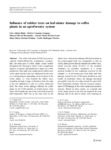Please use this identifier to cite or link to this item:
http://www.alice.cnptia.embrapa.br/alice/handle/doc/972252| Title: | Infuence of rubber trees on leaf-miner damage to coffee plants in an agroforestry system. |
| Authors: | RIGHI, C. A.  CAMPOE, O. C.   BERNARDES, M. S.   LUNZ, A. M. P.   PIEDADE, S. M. S.   PEREIRA, C. R.   |
| Affiliation: | Ciro Abbud Righi, ESALQ; Otavio Camargo Campoe, IPEF; Marcos Silveira Bernardes, ESALQ; AURENY MARIA PEREIRA LUNZ, CPAF-AC; Sonia Maria Stefano Piedade, ESALQ; Carlos Rodrigues Pereira, ESALQ. |
| Date Issued: | 2013 |
| Citation: | Agroforestry Systems, Columbia, v. 87, n. 6, p. 1351-1362, Dec. 2013. |
| Description: | The coffee leaf-miner (CLM) (Leucoptera coffeella Guérin-Mèneville; Lepidoptera: Lyonetiidae), the main pest of coffee plants, occurs widely throughout the Neotropics where it has a significant, negative economic and quantitative impact on coffee production. This study was conducted in a rubber tree/coffee plant interface that was influenced by the trees to a varying degrees depending on the location of the coffee plants, i.e. from beneath the rubber trees, extending through a range of distances from the edge of the tree plantation to end in a coffee monocrop field. The most severe damage inflicted on coffee plants by the CLM (number of mined leaves) from April, which marks the start of the water deficit period, until September 2003 was in the zone close to the rubber trees, whereas the damage inflicted on plants in the monocropped field was comparable to that on coffee plants grown directly beneath the rubber trees, which received about 25-40 % of the available irradiance (Ir-available irradiation at a certain position divided by the irradiation received in full sunlight, i.e. in the monocrop). From May until July damage caused by the CLM nearly doubled in each month. In midwinter (July), the damage decreased perceptibly from the tree edge toward the open field. From September onward, with the rising air temperatures CLM damage in the coffee monocrop started to increase. Based on these results, we conclude that coffee plants grown in the full sun incurred the most damage only at the end of winter, with warming air temperatures. Coffee plants grown in shadier locations (25-40 % Ir) were less damaged by the CLM, although a higher proportion of their leaves were mined. The rubber trees probably acted as a shelter during the cold autumn and winter seasons, leading to greater CLM damage over a distance outside the rubber tree plantation that was about equal to the height of the trees. Future studies should attempt to relate leaf hydric potential to pest attack in field conditions. More rigorous measurements of shade conditions could improve our understanding of the relationship of this factor to CLM attack. |
| Thesagro: | Agrossilvicultura Praga de planta Cafe Coffea arábica Monocultura Consorciação de cultura Seringueira Hevea Sombreamento Bicho mineiro Leucoptera coffeella Performance Caucho Cultivo Continuo Perileucoptera Coffeella |
| NAL Thesaurus: | Agroforestry Plant pests Leafminers Continuous cropping Mixed cropping Shade agroforestry systems |
| Keywords: | Sistema Agroflorestal (SAF) Coffee Rubber tree Agroforestería Cultivo mixto Plagas de plantas Minador de las hojas Sistemas de sombra |
| ISSN: | 0167-4366 (Print) / 1572-9680 (Online) |
| DOI: | 10.1007/s10457-013-9642-9 |
| Notes: | Published online: 5 October 2013. |
| Type of Material: | Artigo de periódico |
| Access: | openAccess |
| Appears in Collections: | Artigo em periódico indexado (CPAF-AC)  |










